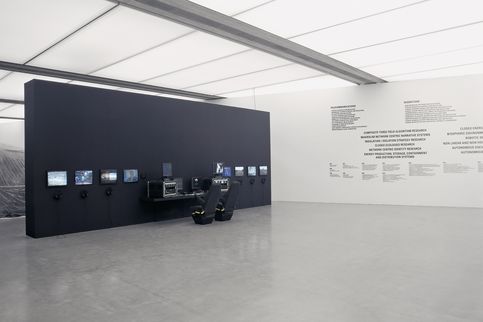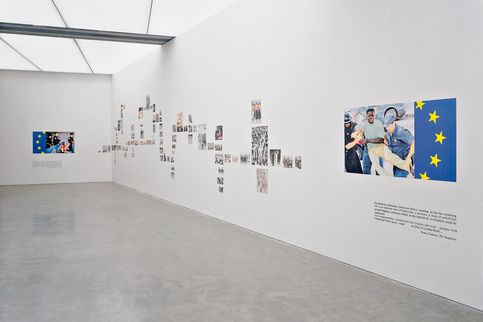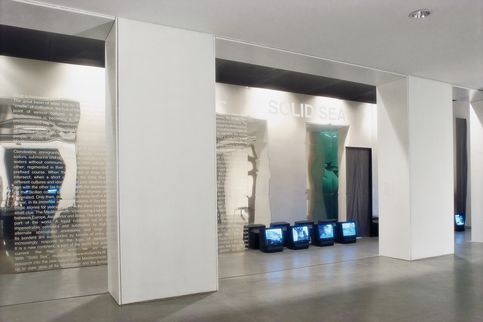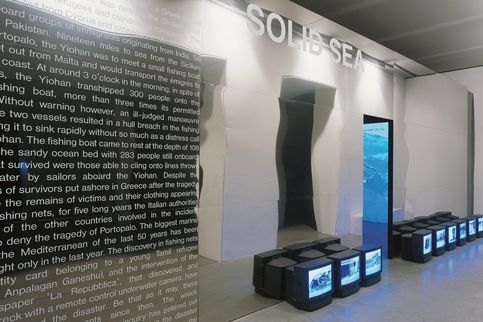Geography
and the Politics of Mobility
Guest Curator: Ursula Biemann
Curatorial Assistance and Exhibition production: Luisa Ziaja
Works by Bureau d’études, Frontera Sur RRVT, Raqs Media Collective, Makrolab, multiplicity.
In 2003, the series of experimental, guest-curated exhibitions at the Generali Foundation were continued by the Swiss artist and theoretician curator Ursula Biemann, who had devised a concept based on the subject of geography and artistic practice. Geography and the Politics of Mobility took five collective projects by international artists - most of which were presented for the first time - and used them to examine the notion of geography, which has been then and today undergoing a radical change. Increased mobility, global migratory movements, and new formations of work manifested in virtual global activities led to new definitions going beyond the realm of geo-science. The circulation of people, data, and goods gave rise to new cultural, social, and virtual landscapes that materially had inscribed themselves onto the terrain. In the frame of this exhibition, geography was seen as a working hypothesis that allowed us to reflect on concepts of demarcation, connectivity, and transgression in society.
In the pictographic installation "World Monitoring Atlas," the artist duo Bureau d'études from Paris (Léonore Bonaccini and Xavier Fourt) visualized the extensive network of data-gathering systems existing between individuals, transnational companies, governments, armed forces, international agencies, and citizens' groups. In contrast to the geographical map, which, based on a phenomenological concept of space, is read analogously, the Organigramm is a digital, structural representation. Such a representation seems to be more commensurate to the real, which can no longer be adequately grasped by photographic means. Bureau d'études often develops its installations in collaboration with the cultural theoretician and journalist Brian Holmes. Prior to this exhibition, they took part in the World-Information Exhibition in Amsterdam, where one of their installations was displayed.
Frontera Sur RVVT (Europe's Southern Border in Real, Remote and Virtual Time - Ursula Biemann, Regula Burri, Rogelio López Cuenca, Valeriano López Dominguez, Helena Maleno Garzon, Alex Muñoz Riera, Angela Sanders) views itself as a loose group of artists and activists. For the exhibition, they carried out a project that had focused on the area near the Spanish-Moroccan border, with its complex layers of meaning. This is a region where issues of sex, ethnic filtering, migration, and labor, as well as technological control mechanisms interact within the public sphere. Work relations on plantations, or in private households, secret boat crossings, and radar patrols - all of these various motivations for mobility layed bare a complex balance of power that reformulates the metaphorical and material constitution of borders.
Makrolab, founded by the Slovenian artist Marko Peljhan in 1994, was a nomadic, temporary research station that had allowed changing participants to monitor data flow from all over the world in remote locations and under isolated conditions. For this, artists and scientists developed autonomous laboratory projects that beared a relationship to each respective environment. The installation that was shown in the exhibition, documented the two-month laboratory project in the Scottish Highlands in summer 2002 based on video clips that were taken on site and audio-visual artistic works, combined with inserts of news reports in real time. In addition, a wall installation highlighted the essential thematic fields and goals of Makrolab and indicated a time line of venues for the installation in Germany (Documenta X), Slovenia, Australia, and Scotland, as well as then planned future locations. In 2007, Makrolab would go to the Antarctic and be set up as a permanent art/science laboratory.
Operating from Milano, the multiplicity collective (Stefano Boeri, Maddalena Bregani, Francisca Insulza, Francesco Jodice, Giovanni La Varra, Armin Linke and John Palmesino) presented "Case 01 + 02," part of its at then times ongoing project "Solid Sea," a new study of the changed conditions in the Mediterranean region. Multiplicity imagined the sea as a solid mass, examining it from several angles and using various forms of representation - maps, photographs, and videos. It explored both the streams of movement that traverse it and the identity of the individuals that inhabit it. The first case study for Solid Sea has been presented at Documenta 11; the at then times new work, "World Odessa," concerned two ships that are anchored at the coastal city of Naples.
In its video and text installation "A/S/L"(Age/Sex/Location), Raqs Media Collective (Monica Narula, Jeebesh Bagchi and Shuddhabrata Sengupta) used the example of women working as teleworkers in India to illustrate gender-specific working conditions within the out-sourced online data industry, which has seen considerable expansion then and today, especially in India. The working conditions of this new "digital proletariat" necessitate constantly switching between the online and offline worlds, between the respective cultural and economic situations. The reality of one realm is carried by the inequality of another.







